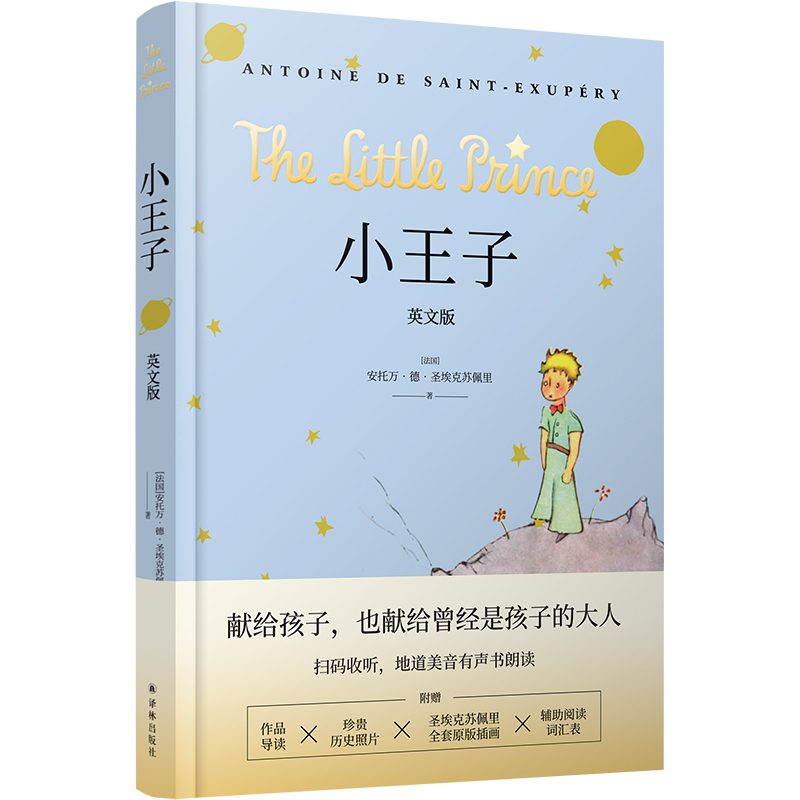
出版社: 译林
原售价: 32.00
折扣价: 0.00
折扣购买: 小王子(英文版)
ISBN: 9787544783859

圣埃克苏佩里,法国诗人、作家,☆早一代飞行员之一。1900年,生于里昂的一个天主教贵族家庭;1926年,进入航空公司做邮航飞行员,开辟多条非洲及南美航线,期间创作《南方邮航》《夜航》《人的大地》;二战期间加入法国空军,反对纳粹德国,法国战败后愤而流亡美国,创作了《空军飞行员》及代表作《小王子》。1944年,高龄重返法国空军,执行侦察任务。7月31日在第九次任务中,再也没有返航,消失在湛蓝的天空。圣埃克苏佩里的一生与其创作的童话人物小王子一样传奇,1967年,奉入法国先贤祠,成为法国历代72位伟人之一。
I ONCE WHEN I WAS six years old I saw a magnificent picture in a book, called True Stories from Nature, about the primeval forest. It was a picture of a boa constrictor in the act of swallowing an animal. Here is a copy of the drawing. In the book it said: “Boa constrictors swallow their prey whole, without chewing it. After that they are not able to move, and they sleep through the six months that they need for digestion.” I pondered deeply, then, over the adventures of the jungle. And after some work with a colored pencil I succeeded in making my first drawing. My Drawing Number One. It looked something like this: I showed my masterpiece to the grown-ups, and asked them whether the drawing frightened them. But they answered: “Frighten? Why should any one be frightened by a hat?” My drawing was not a picture of a hat. It was a picture of a boa constrictor digesting an elephant. But since the grown-ups were not able to understand it, I made another drawing: I drew the inside of a boa constrictor, so that the grown-ups could see it clearly. They always need to have things explained. My Drawing Number Two looked like this: The grown-ups’ response, this time, was to advise me to lay aside my drawings of boa constrictors, whether from the inside or the outside, and devote myself instead to geography, history, arithmetic, and grammar. That is why, at the age of six, I gave up what might have been a magnificent career as a painter. I had been disheartened by the failure of my Drawing Number One and my Drawing Number Two. Grown-ups never understand anything by themselves, and it is tiresome for children to be always and forever explaining things to them. So then I chose another profession, and learned to pilot airplanes. I have flown a little over all parts of the world; and it is true that geography has been very useful to me. At a glance I can distinguish China from Arizona. If one gets lost in the night, such knowledge is valuable. In the course of this life I have had a great many encounters with a great many people who have been concerned with matters of consequence. I have lived a great deal among grown-ups. I have seen them intimately, close at hand. And that hasn’t much improved my opinion of them. Whenever I met one of them who seemed to me at all clear-sighted, I tried the experiment of showing him my Drawing Number One, which I have always kept. I would try to find out, so, if this was a person of true understanding. But, whoever it was, he, or she, would always say: “That is a hat.” Then I would never talk to that person about boa constrictors, or primeval forests, or stars. I would bring myself down to his level. I would talk to him about bridge, and golf, and politics, and neckties. And the grown-up would be greatly pleased to have met such a sensible man. II SO I LIVED my life alone, without anyone that I could really talk to, until I had an accident with my plane in the Desert of Sahara, six years ago. Something was broken in my engine. And as I had with me neither a mechanic nor any passengers, I set myself to attempt the difficult repairs all alone. It was a question of life or death for me: I had scarcely enough drinking water to last a week. The first night, then, I went to sleep on the sand, a thousand miles from any human habitation. I was more isolated than a shipwrecked sailor on a raft in the middle of the ocean. Thus you can imagine my amazement, at sunrise, when I was awakened by an odd little voice. It said: “If you please—draw me a sheep!” “What!” “Draw me a sheep!” I jumped to my feet, completely thunderstruck. I blinked my eyes hard. I looked carefully all around me. And I saw a most extraordinary small person, who stood there examining me with great seriousness. Here you may see the best portrait that, later, I was able to make of him. But my drawing is certainly very much less charming than its model. That, however, is not my fault. The grown-ups discouraged me in my painter’s career when I was six years old, and I never learned to draw anything, except boas from the outside and boas from the inside. Now I stared at this sudden apparition with my eyes fairly starting out of my head in astonishment. Remember, I had crashed in the desert a thousand miles from any inhabited region. And yet my little man seemed neither to be straying uncertainly among the sands, nor to be fainting from fatigue or hunger or thirst or fear. Nothing about him gave any suggestion of a child lost in the middle of the desert, a thousand miles from any human habitation. When at last I was able to speak, I said to him: 《小王子》是法国作家圣埃克苏佩里1942年创作的童话,已译成一百六十多种语言,被誉为“经典中的经典”。故事蕴含着关于爱情、友谊、死亡,以及人类生活状态的思索,获得了哲学家萨特和海德格尔的盛赞。出版七十余年来,总发行量仅次于《圣经》,不断被改编成戏剧、影视作品,打动了全世界无数的人。它陪伴了孩子成长,也触动了大人的童心,很多人仍然相信作者圣埃克苏佩里像小王子一样,回到了他的B-612星球。 本版《小王子》为英文版,力争还原1943年英译本初版,收录全套原版全彩插图、珍贵历史照片。扫码可听地道美音朗读,并附送辅助阅读词汇表。
